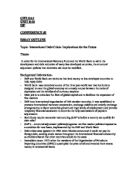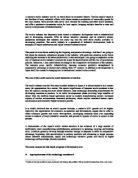Not only has the increase of interest rates proved the repayment of debts to be incredibly difficult, furthermore these indebted countries are obliged to repay their debts in hard currency. Developing countries have soft currencies, therefore, when the value of a developing country's money goes down the cost of its debt rises. It takes more of the country's own currency to pay back the same amount of hard currency.
The debt crisis is an immense problem for less developed countries, which could seem to go on for an eternity. In 1996 indebted countries paid almost £330 million interest on their debt every day to the banks, governments and financial institutions of the north. It is estimated that, every 5 seconds a child dies because of Third world debt. In 1993, rich nations took back £3 in debt repayments for every £1 they gave in economic aid to the poor nations. Presently, every man woman and child in less developed countries owes £250, which is more than an average year's wages. (Source: Third World Debt & Jubilee 2000 [online]. Available from: http://www.hibbert.org.uk/responsibility/debt.html. [Accessed 02/05/02]). It is alleged that every baby born in the developing world owes $482 at birth. (Source: Third World Debt Crisis [online]. Available from: http://www.derby.ac.uk/seas/geog/jollyfranc/third_world_debt.htm. [Accessed 02/05/02].
The loans were made with certain conditions known as Structural Adjustment Programmes in order to obtain more foreign currency, governments implementing these programmes are usually expected to spend less on health, education, social services, devalue national currency, lowering export earnings and increasing import costs, cut back on food subsidies, which causes prices to soar, to encourage privatisation of public industries, and to take over small subsistence farms for large scale export crop farming instead of staple foods.
A number of solutions have been proposed to try to relieve the international debt crisis. In the late 1970s and early 1980s, the International Monetary Fund negotiated rescheduling agreements in an attempt to decrease the burden of debt repayment on developing countries. They also endeavoured to change economic policies in order to avoid the need for future loans. Although the governments of the debtor countries accepted this proposal, the public were resistant to the economic rigidity that was required.
In the early 1980s, the world was faced with recession and many less developed countries were on the verge on reneging on their debts. In 1985, the ‘Programme for Sustained Growth’ was agreed, aiming to reduce the burden of the International Monetary Fund’s austerity policies and to relieve the pressure on social stability brought on by both the strict policies and those attempting to reduce imports. (Griffiths, A. & Wall, S. (1999). Applied Economics. Pp 726).
Another suggested solution is that concessions should be required from commercial banks, governments and the international financial institutions, in particular the reduction of the accumulation of the stagnant debt of the poorest countries which are impossible to pay.
It is also argued that there should be consideration for an international insolvency procedure that will allow international debts in future to be settled in a transparent and open court of arbitration at which both debtor and creditor may appoint an equal number of arbitrators.
Creditors might be subject to a new discipline and debtors will need help to recover from a long period during which vital resources were siphoned out of their economies.
There have been a number of campaigns in recent years to cancel third world debt, such as ‘Jubilee 2000’ and the ‘Drop The Debt’ campaign. Both of these campaigns declare that the debts of less developed countries should be wiped out since much of the debt has been paid many times over due to the interest payments. Jubilee 2000 states that “the backlog of unpayable debt of governments of poorer countries can never be removed, except by an agreed remission on the part of creditors. For the sake of ending the slavery of debt, and for creating a new and disciplined beginning in financial relations between rich and poor countries, remission of these debts should be achieved by the year of redemption - Jubilee - the year 2000.”(Third World Debt & Jubilee 2000 [online]. Available from: http://www.hibbert.org.uk/responsibility/debt.html. [Accessed 02/05/02]). Jubilee 2000 believes that a country should be able to be declared bankrupt as an individual would. Then could then cancel their debts and invest money into the developing of their country, aiming to reduce their dependence on richer countries.
There have been numerous personalities from the music industry who have become involved in the campaigns for cancelling the third world debt. One example of personalities involved is Bono, lead singer of U2. Bono was involved in the Jubilee 2000 campaign and has also made suggestions that the interest rates payable on international debt should be radically reduced. "Refinancing means a less burdensome route to hit Third World principal. Otherwise, struggling nations are just treading interest and where does that leave us?" (Bono. Cited in: Bono To Refinance Third World Debt at Low 8 ½% APR. [Online]. Available from: http://www.dartmouth.edu/~jacko/news/bono_debt.html. [Accessed 02/05/02]). There was also the involvement on REM, among others for the Drop-the-Debt campaign at a free concert held in Trafalgar Square in 2001.
Why is it that these personalities from the music industry sacrifice their time and money in order to help raise awareness and funds to aid the international debt crisis? The involvement of music industry personalities in various charities is not a new phenomenon; there have been a number of concerts and such organised to raise awareness and funds for a number of causes. Probably the most famous of which was ‘Live Aid’, organised by Sir Bob Geldof to raise money for Africa. The involvement of these people may be due in part to personal ethics, which a personality such as Bono can express due to their attainability.
The involvement of music industry personalities in benefit concerts and awareness campaigns may be viewed as a simple publicity stunt, what better way to draw attention to yourself than to become a human right activist? These people have much influence on their fans and also have access to bodies involved in international debt management. They can use this influence and access to help make a difference. The involvement in such charities may also give these personalities a greater sense of worth and make them feel that not everything is about making money for themselves.
It is not a universally shared view that the third world debt should be cancelled. There are many people who believe that developing countries should pay back what they owe to the developed world, irrespective of the economic hardships that they face. It makes economic sense for people to repay their debts. “Western governments and creditors cannot be expected to write off debts owed by developing countries as this move is considered to be against the principle of economics. Such move is considered to be unfair to other countries that struggle to repay their debt.” Third World Debt Crisis [online]. Available from: http://www.derby.ac.uk/seas/geog/jollyfranc/third_world_debt.htm. [Accessed 02/05/02].
Although it may be a desirable idea, cancelling Third World debts now will not solve the problem in the future. To do that, the present financial system needs to be reviewed. The current system is based on debt and interest payments, a system that keeps control in the hands of those who are rich and powerful.
Bibliography
Griffiths, A. & Wall, S. (1999). Applied Economics. Pearson Education Ltd. Harlow.
Chossudovsky, M. (1998). “'Financial warfare' triggers global economic crisis” [online]. Available from: http://www.twnside.org.sg/title/trig-cn.htm. [Accessed 25/03/02].
Danaher, K. A New Approach to the Third World Debt Crisis. [Online]. Available from: http://www.globalexchange.org/economy/alternatives/debtCrisis.html. [Accessed 02/05/02].
Rogoff, K. (1991). Third World Debt. [online]. Available from: http://www.econlib.org/library/Enc/ThirdWorldDebt.html. [Accessed 25/03/02]
Roodman, D.M. (2001). The Third World Debt Crisis: Facts and Myths. [Online]. Available from: http://www.worldwatch.org/pubs/paper/155facts_myths.html. [Accessed 02/05/02].
Bono To Refinance Third World Debt at Low 8 ½% APR. [online]. Available from: http://www.dartmouth.edu/~jacko/news/bono_debt.html. [Accessed 02/05/02]
Third World Debt Crisis [online]. Available from: http://www.derby.ac.uk/seas/geog/jollyfranc/third_world_debt.htm. [Accessed 02/05/02]
Third World Debt & Jubilee 2000 [online]. Available from: http://www.hibbert.org.uk/responsibility/debt.html. [Accessed 02/05/02]
http://www.thirdworld2000.org/







